THE INDIGENOUS PEOPLES OF THE CALCHAQUI VALLEYS
The Diaguita Tribes
Written by Martin Pekarek
edited by Jodi Lorimer, translated by Valentina
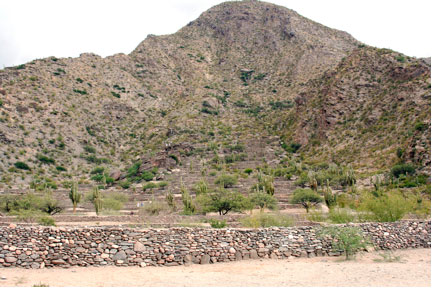
Historical Background
In 1535 Diego de Almagro was commissioned by the Spanish crown to occupy Collasuyu, the southernmost region of the Inca empire. With 200 Spanish soldiers and 2000 Indian mercenaries from Peru, he marched over the Puna de Atacama into what are today the provinces of Jujuy and Salta. The Spanish conquerors fought their way to the Calchaquí region where they defeated the Pulares indians in Chicoana and other tribes. The local ethnic unity was destroyed and the chiefs, priests and administrators of the Incan Empire were replaced by Spanish conquerors. These were adventurers and mercenaries from the lowest social level, drawn by the promise of gold and land. But the local people had nothing to offer that the Spaniards deemed valuable. The conquerors’ hatred of the indigenous people and their lifestyle led them to ignore the local people as long as they remained peaceful. This, combined with the language barrier, made it easier for the natives to preserve their ideology and magical cosmology out of sight of the brutal conquerors. It had been only a few generations since the Inca had conquered them and their resigned acceptance of the new Spanish overlords eased the transition. However, their life style and their technical knowledge was not lost. Furthermore, there were some tribes living far from the Spanish settlements, which were able to maintain their traditions. Many indigenous cultural elements, especially those pertaining to spiritual matters, the arts and healing, exist today in their original strength.
 Eight years after the arrival of the conquerors, Diego de Rojas reached the province of Tucuman, named after the Indian spiritual leader Tucma who later became a priest at the Indian reservation. This camp was built for the Indians of Tucumangasta who had converted to Christianity, (“gasta” meaning village of Tucma). The Calchaquí Valley region was the most southern edge of the Inca Empire. In the Diaguita language the name for this place is literally, “where the Inca Empire ends”. Until 1630 these people of North Argentina were enslaved by the Spaniards and forced onto reservations. The Abaucanes, Yocaviles and Quilmes tribes, unlike other groups, resisted colonization up to the second Calchaquí war at the end of the 17th century. Finally, the battered remnants of the Quilmes tribe were rounded up and force-marched hundreds of mile south to Buenos Aires where the few survivors were settled in an environment drastically different from their homeland. This district of Buenos Aires bears their name, Quilmes.
Eight years after the arrival of the conquerors, Diego de Rojas reached the province of Tucuman, named after the Indian spiritual leader Tucma who later became a priest at the Indian reservation. This camp was built for the Indians of Tucumangasta who had converted to Christianity, (“gasta” meaning village of Tucma). The Calchaquí Valley region was the most southern edge of the Inca Empire. In the Diaguita language the name for this place is literally, “where the Inca Empire ends”. Until 1630 these people of North Argentina were enslaved by the Spaniards and forced onto reservations. The Abaucanes, Yocaviles and Quilmes tribes, unlike other groups, resisted colonization up to the second Calchaquí war at the end of the 17th century. Finally, the battered remnants of the Quilmes tribe were rounded up and force-marched hundreds of mile south to Buenos Aires where the few survivors were settled in an environment drastically different from their homeland. This district of Buenos Aires bears their name, Quilmes.
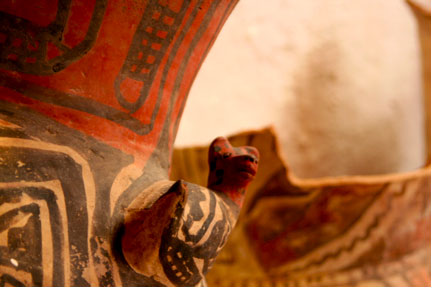
The Calchaquí Diaguita
Spectacular valleys and canyons are carved into the homeland of the Diaguita tribes. Although some areas appear inhospitable, many of the valleys are ringed by snow-capped mountains that provide water to the valley floor all year around. Ingenious storage and irrigation techniques encouraged the Diaguita desert to bloom. The microclimates allow for growth of traditional Andean plants such as maize, quinoa, carob trees and different kinds of potatoes, all of which are still produced today. A rich variety of wildlife provided the people with meat, wool, leather, feathers and other raw materials. These included vicuna, llamas, alpaca, deer, agoutis, armadillo, reptiles, turkey hens, parrots, condors and many more. The valleys have a desert-like climate spread with cacti and carob trees and a wide temperature variance from day to night. The two most important rivers are the Santa María flowing north and the Calchaquí flowing south. They flood the valleys during the torrential rains of the summer with fertile sediment, renewing the soil annually. Near Cafayate, both rivers meet and together reach the Cabra Corral dam. Here, it becomes the Juramento River and flows southwards for hundreds of kilometers until it reaches the Paraná River, eventually making its way south to the Atlantic Ocean. Although this region is geo-politically divided into three provinces, it is really a geographical, ethnic and historical unit. The province of Catamarca has the Yocavil Valley, the Quilmes Indians lived in the province of Tucuman and the Calchaquí Valleys are in the province of Salta.
 The Calchaqui tribe is the one that is most commonly referred to by the name ‘Diaguita’. The word “Diaguita” derives from “tiac-y-ta” and means “village inhabitant” in the Calchaqui language, Kakan. The Calchaquis embody the characteristics of several tribes described by the Spaniards and Jesuits. However, considering the ruling ideology of those times, we should accept this with a critical view.
The Calchaqui tribe is the one that is most commonly referred to by the name ‘Diaguita’. The word “Diaguita” derives from “tiac-y-ta” and means “village inhabitant” in the Calchaqui language, Kakan. The Calchaquis embody the characteristics of several tribes described by the Spaniards and Jesuits. However, considering the ruling ideology of those times, we should accept this with a critical view.
The name Calchaquí appears for the first time in 1556 in the writings of the Jesuit Aguirre. From 1562 after the first Indian revolution, to differentiate them from other ethnic groups and to place them within a geopolitical region, these people are explicitly named Diaguitas of the Calchaquí, Calchaquíes or Diaguita Tribe. According to the ethnolinguist Samuel Lafonte Quevedo, the word Calchaqui comes from the Quechua language and means “bad tempered”. This may be because the Spanish Governor of the time described the natives of the Calchaquí Valleys as “angry, irritable and untamable”. Another possible interpretation could be the translation of the Quechua word “calcha” meaning “collection” or “harvesting” which may refer to the fertility of the region. A further reference to the origin of the name may be the original topographical meaning of “Calchaquí”, which was given to a respected chief. In 1630 it became the official ethnic and geographical name. Chief Juan Calchaquí from the Angastaco, revolted in 1558 with the support of the Diaguita tribes against the colonial lords and kept them at a distance for a year.
From original ethno historical chronicles and letters from governors to the King of Spain we have gleaned contemporary information about the social organization, political structure, war techniques and clothes of the Calchaquí people. These sources, however, tell us nothing about their views on life, their religious awareness, games, dances, music, oral tradition or myths, the technological know-how involved in the construction of agricultural terraces, the smelting of metals, ceramics production or irrigation systems. However, archaeology helps to give us some clues and museums and private collections also contribute to a reconstruction of the pre-Spanish past. These finds also allow us to compare and contrast the Calchaqui artifacts with discoveries in other regions.
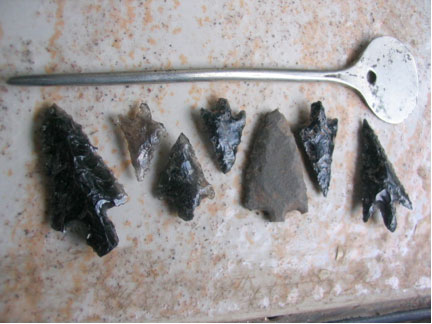
Indigenous architecture
From about 1000 AD, the Diaguitas built large villages that could sustain as many as 3000 people in a farming community. However, warfare occurred and in this region there are many archaeological sites demonstrating two different kinds of buildings; those dwellings designed for peaceful daily community living and those built for times of war. The ruins in Chicoana-Chivilme, tell us about the daily life of the Diaguitas. They build fortified villages with water reservoirs and silos as well as farming terraces reinforced with stone. The peaceful villages had square homes similar to adobes in the American Southwest built out of clay, straw, bamboo and wood and which is typical even today for traditional Andean houses. In the ruins of the town of Quilmes, the dwellings were adapted to the hot climate and available materials. The houses were partially subterranean to protect from the heat, built of loose stone, with partial roofs of cactus wood. The center of the structure was open to the sky and these patios were connected to circular roofed chambers used for storage or possibly living space.
Pedro Lozano, in his “Historia” of 1892, describes the “pucarás” as fortified constructions of stone in high strategic places, to be reached by stone steps. To survive invasion by enemies, they exercised creativity and great resourcefulness. In case of invasion or isolation, they built water reservoirs in these high places. These can still be visited today at the ruins of Aconquija in Andalgala, province of Catamarca as well as those in Quilmes. The location of the town of Quilmes was a brilliant strategic decision. The ruins are surrounded by a wall and nested up against the mountain. Water was available from springs and the snows up above and, from numerous lookout points, anyone approaching the town could be seen from miles away.
Skillful use of resources
The indigenous people made good use of every resource available to them. In the high elevations of the Sub-Andes “Puna” they mined for gold and silver and extracted salt and obsidian used for spears and arrowheads. In the enormous flatlands at these heights, llama and vicuña herds abounded, which provided the people with necessary wool and meat, but also transport capabilities. The feathers of the condor and hawks were treasured symbols of respect. The most productive region for agriculture was further down the mountains where farming terraces were built. From the tropical forest region the Indians traded caravans of logs, honey, wax, pumpkins, pigments, feathers and fruit. All these products provided the Indians with a healthy and varied diet.
The Diaguitas were famous for their ceramic objects using special glazing techniques and fine craftsmanship. In order to produce a ceramic object, the adequate clay must first be selected, the shape chosen, the oven built, the temperature controlled and have the artistic talent for its decoration. Proof of their skill can be seen in burial urns about 25-74m high, ceramics used for ceremonies, cooking utensils, and zoomorphous and anthropomorphous vessels with various functions.
They were also masters in working metal objects requiring great metallurgical knowledge. They produced jewelry, bells, breast shields and bronze tools. Because of these highly developed techniques and products the Calchaquí Valleys were very attractive to the invading Incas.
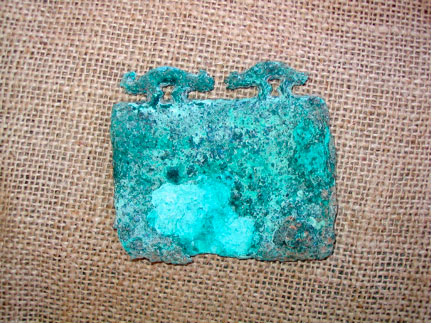
Clothing
According to chronicles, descriptions, petroglyphs, ceramics and ethnohistorical material, the people of the Calchaquí valleys possessed extensive capabilities with textiles. Anthropologists describe the clothing found at different sites; ponchos, tunikas, aguayos and many more. Both textiles and ceramics were colored with vegetable pigments. Black and shades of green were made from the carob tree, violet from cacti flowers, and brown from different resins. They wore a long collarless one-piece garment without pockets (“unku”) and added a leather or textile belt before going hunting or at social gatherings and they wore leather sandals called “ushutas”. Valuables were kept in a small textile bag. The women wore a “tunika” which differed according to their social status: colourful for the young girls and a single colour for the married ones. The material was made out of llama wool or vicuña hair, and these are still being produced today. We can still find in the 21st.century, the Diaguita shepherdesses spinning their wool while they herd their animals, using the old “torteros” a large carved stone button as counterweight.
Of special importance to the Calchaquí was their hairstyle. They wore it long, and it was considered despicable to cut a person’s hair. According to the writings of Quiroga in 1903, one of the most insulting punishments inflicted by the Spaniards was to shave off the Indians´ hair. Pincers made of copper lead us to believe that the Diaguita plucked their hair with an eye to fashion. They decorated their straight, black hair with headbands, feathers, plaits, and hair needles made from cactus wood, horn, and silver. In early times even an occasional deformed skull was incorporated into a hairstyle.
Valuable jewelry was made in various zoomorphic shapes from precious metals. Silver and gold plates were fashioned into pectorals, bracelets, discs for the forehead and sewn into clothing. Pins to close tupus had filigree decorations. Necklaces and earrings were made of both precious and semi precious stones.
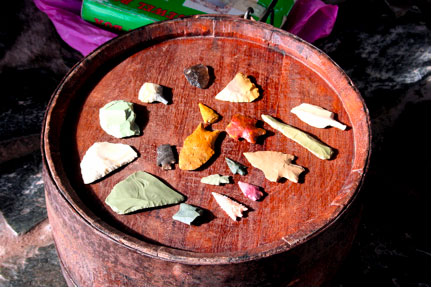
Language preservation
The inhabitants of Latin America are the product of a mixture of different cultures, many speaking different languages. Andean Spanish is a variation of Spanish which has been influenced by Quechua, the language of the indigenous people from South Colombia, Ecuador, Peru, Bolivia and Northwest Argentina. A new linguistic policy originating from work conducted at the National University of Salta states the important objective of preserving the rich idiomatic expressions and cultural inheritance of Quechua. This is not only because of the native speakers that still live in the province of Salta, but also because of the general language characteristics of the region. Schools are supposed to encourage the preservation of the spoken language of Quechua while teaching the official written Spanish language. This new teaching method allows the children to be bilingual, respects and supports the linguistic variety of the region and validates the indigenous language and culture. These new teaching methods allow all family members to participate. Whether these new ideas remain a dream for the natives or whether they become real, depends very much on the decision of these different cultures to try to live together as equals, enriched by a complex national identity.
The present situation
The people of Northwest Argentina today are strongly imprinted with ancient traditions, rites, practices and ethno linguistic elements. Local authorities meet with representatives of indigenous folk to discuss matters pertaining to every day life and the identity of their people. These include land rights, language, religions missions, rituals honoring “Pachamama”, or, Mother Earth, loss of cultural identity, carnival, sun celebrations, and social and cultural questions regarding education and health. As we find all over the world, it is the cities that bear most of the responsibility for the loss of traditional values. In spite of materialism, Christianity, immigration and globalisation, the people in the interior of the northwestern provinces of Argentina have managed to preserve much of their culture. In recent years a strong interest in indigenous cultural roots has reawakened. For example, in 1985 laws were passed to support indigenous groups and facilitate their integration into modern society while protecting their heritage. These included the allocation of traditional property, health care and political representation. However, laws are not always followed. The excuse is always the bad economic situation of the country. In the seventies, the Association of Argentine Indians (AIRA) defined their objectives in several congresses. Foremost was attaining equal status and cultural enrichment. According to the last census made in 1976, 350,000 native people live in Argentina, about 1.2% of the total population. In the provinces of Salta and Jujuy the percentage is much higher.

